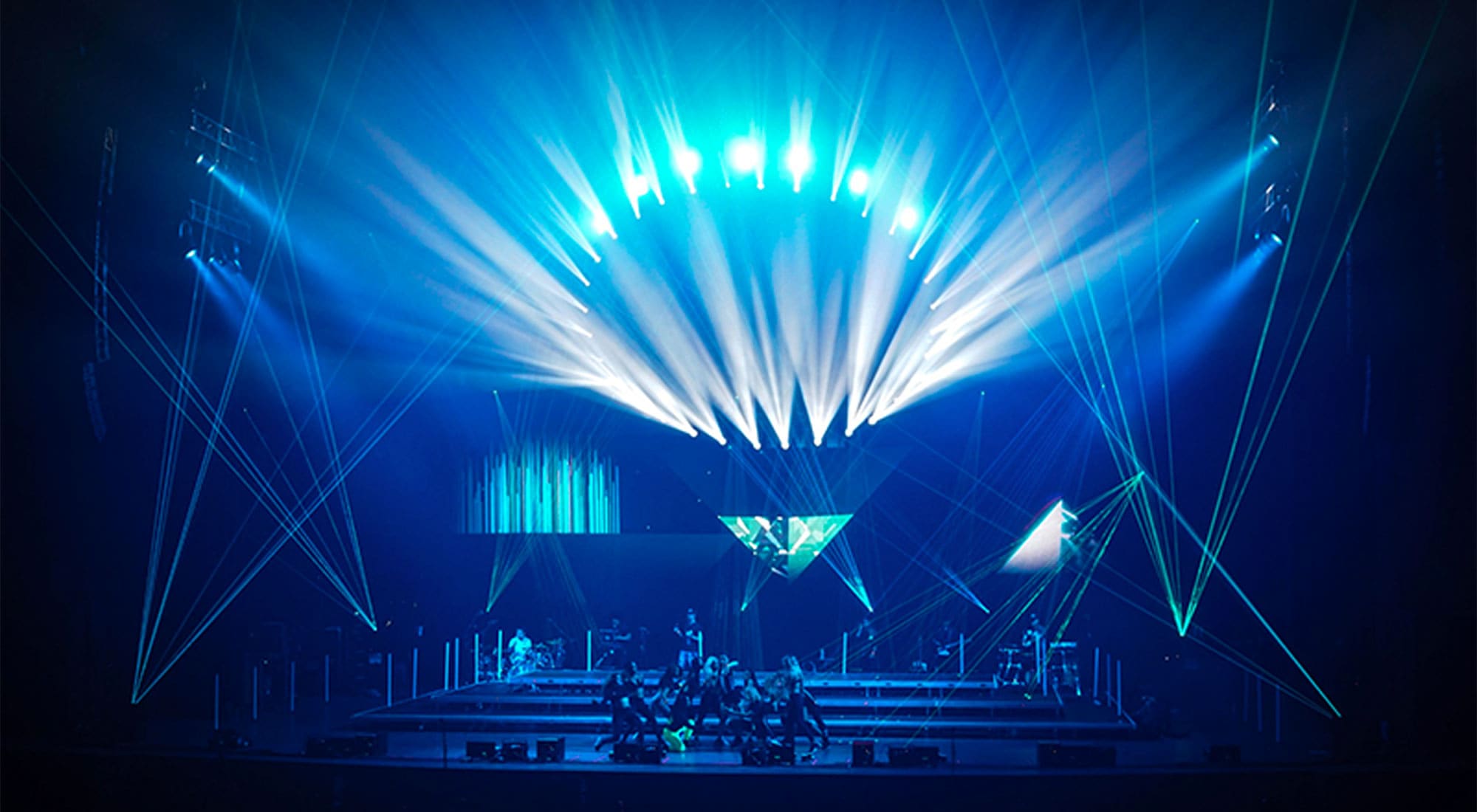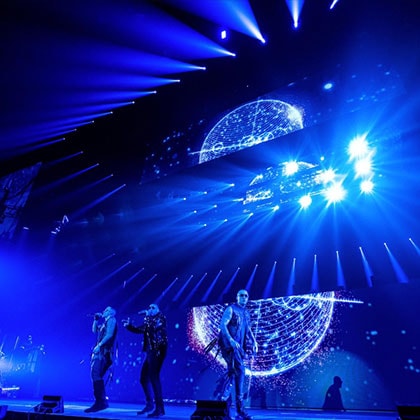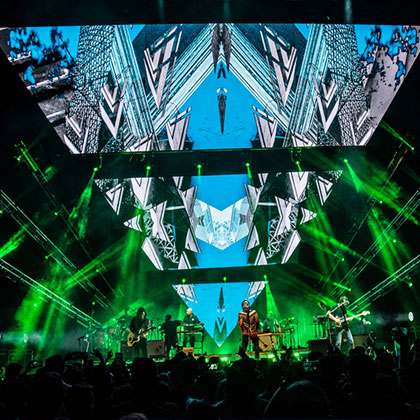
The prolific 30+ year career of Lighting Designer Alain Corthout of Showplus has taken him from Vari-Lite tech in his native Belgium, to consummate programmer, to much-respected and sought-after designer working with some of the biggest names in the Latin American music scene. His dynamic, large-scale visions, for artists including Italy’s Laura Pausini and superstars of the Latin American music scene including Miguel Bosé, Maluma, Chayanne, Wisin & Yandel, Alejandro Fernandez, Juanes and many more have graced stages across the world.
Where and when did the interest in lighting begin for you?
When I was at school, I sometimes worked as a stagehand at shows at the big local arena in Antwerp. One of the shows I worked at was Prince – the Sign Of The Times tour. That was the first time I saw the VL1. I said to myself, standing at FOH and watching the operator, ‘This is what I want to do!’ That was 1987.
How did your career progress from there?
Soon after I finished school I started working at the Belgian Vari-Lite office as a tech, trying to move on to operating on the Vari-Lite desk of that time, the Artisan. I also worked at a club, where we had the first Golden Scans running on a Zero88 control desk.
You have worked extensively as both a programmer and designer - which do you prefer, and why?
I like both, really. I have worked with great designers as a programmer and operator, and I have designed a lot of shows for Latin artists based in the USA and South America. I prefer to program those myself before I give them to the touring operator, because I feel that goes faster.
What advice would you give to those who aspire to follow in your footsteps?
Learn about every step in the game, go through every single phase, being stage-hand, tech, crew chief, operator etc. Learn about the lights, open them up and see how everything works. Don’t stay behind your desk waiting till the set is built - be involved. We are never too old to learn. Challenge yourself!
Do you have any personal career highlights that come to mind? What achievements have given you the greatest satisfaction and why?
There have been so many. I have a very special bond with one artist in particular, Miguel Bosé. Together we have created some very nice designs for many tours.
You have frequently collaborated with Ignace D’Haese of Arf & Yes. How did that connection come about?
He’s like my mentor and guru. He is a great designer and his team are amazing. I have programmed shows for him for 30 years now! And we keep on going strong. I am proud to have been part of many of their big projects.
How do you think of yourself, and how do you describe what you do, in terms of ‘art’ and ‘tech’?
I come from the more technical side, so I think it’s important to draw influence from, and collaborate with, people who don’t necessarily know anything about tech, but who are very artistic: together you can create something great!
Do you think you have a ‘style’ of lighting? If so, how would you describe it?
I probably do, but I wouldn’t know how to describe it. Sometimes I get people saying they could see it was my work, like a signature, but it’s not something I do on purpose. My programming is very dynamic and timing is everything. I can be very annoying if I work with other programmers who work on other desks that are not my preference, because I want things to go fast and some desks are simply impossible to program fast!
What are your lighting design rules?
I don’t have any specific rules.
When you approach a new design, from where do you draw your inspiration? For example, from the music, the artist, the target audience?
From the music, yes, but first I get a lot of inspiration from architecture, art, shapes, and then I see if a certain shape or structure fits the style of the artist. And from there on, we see if the budget meets the idea!
Show production calls for high-level collaboration, with exceptional communication and understanding between disciplines. What techniques have you developed to ensure that this process runs as smoothly as possible?
There can be a lot of time wasted in getting lost in poor communication. Luckily, I deal with some very good production managers. But there are times . . .
What traits do you admire most in the creatives you collaborate successfully with?
Collaboration and sharing is the future. There are old-school people who try to do as much as they can by themselves, but collaboration is the only way to create better shows.
You have carved an impressive niche in Latin American music scene. How did that come about?
Well, thanks to Ignace at Arf&Yes, I was introduced into that market, programming for a big Latin artist. From there I rolled into programming and then designing for other artists through the same management. I gradually got into the Latin American market and many other Latin artists started requesting design and programming services. I have been lucky that they like my work.
When you approach a new design, do you think in terms of specific lighting fixtures, or do you think just in terms of the desired light effect/performance?
When designing for tours that don’t travel with equipment, you have to know what types of lights are common in all those countries that the client will tour. I will make an A list of equipment, and then a B list with alternatives.
I don’t put many special lights on the list, because I know most countries don’t have the newest gadgets. Some tours can afford to travel with specials, but most don’t, so I try to keep the list simple, with a few types of spots and washes, but always good brands. If you can only afford 100 fixtures, they had better be good - and then there are few options.
I know, more or less, what the inventory of a certain brand is in each country, because I ask the manufacturer which company owns what. Many lighting rental companies are complaining about all the riders with so many different lights, especially all those funky new dinky toy fixtures that are funny today, but boring tomorrow - and this is a problem.
Ten years ago, a lighting company would buy a load of VL3500 Wash, and you know, they are still working fine. But now, there’s a thousand brands with a lot of crap, and those lights are built to work for one year and then go to the trash bin.
Or there are brands that bring out a new version of a light every six months, and that drives the lighting companies insane too, because in six months, their stock has lost value. It’s going to be very interesting in the coming years, but I think the companies that make just a few types - but good types - of lights, will remain. All the dinky toy manufacturers will disappear.
Which other Lighting Designers do you particularly admire?
There’s a few!
What are the main performance attributes you look for in a luminaire?
Definitely color and light quality. When you have 100 lights of the same type, you want all of them to match perfectly. And regarding color, the colors and the optics of the Vari-Lite products through history have always been superior.
What do you think of the current state of LED-based stage lighting fixtures on the market?
The LED engines in spot fixtures are getting very good in terms of color, but not yet super bright. The LED washes are all over the place – there are many ugly LED wash fixtures out there. Instead of doing it like they do with the spots, where the light comes through a lens, which makes it way nicer to look at, the beam of so many LED washes is ugly - not a solid beam, a mess in color, and a lot of differences between same types.
When specifying fixtures, how far is low power consumption a consideration for you?
Not at all.
You recently spec’d VL10 BeamWash fixtures for Maluma – why did you choose that fixture, and what is your opinion of it?
I love the VL10. I have used it on other projects as well. It’s way better than the [competition, which] is not even close to the VL10.
What’s missing from the LD’s current lighting toolkit? Is there anything different you would like to see from manufacturers?
I think manufacturers should probably ask the LDs first what they want, and send prototypes and then adjust according to the feedback and requests of the LDs. There’s so many fixtures out there where LDs are wondering who invented some of the features that are not necessary.
Ask the programmers as well! Many times when we’re programming a show, we find that certain fixtures behave weirdly because of a certain thing, or that they are very slow because of another reason, and that’s not OK. On occasion, I have requested new hardware modes because it was totally necessary, and got the manufacturer to do it, but that’s maybe because I can. But there are many more programmers out there who need the same level of support. It’s not just about the lighting designers!




